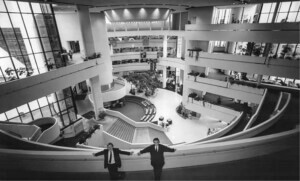Designing the Forest and Other Mass Timber Futures | Lindsey Wikstrom | Routledge | $39.95
This excerpt was originally published in Mattaforma cofounder Lindsey Wikstrom’s book, Designing the Forest and Other Mass Timber Futures, published by Routledge in 2023. The passage below is excerpted specifically from the concluding chapter, “Underpinning,” which examines the invaluable role that storytelling plays in our conceptions of earth, ecology and systems thinking.
In Ursula K. Le Guin’s The Word for World is Forest (1976), earth has become a concrete wasteland. A military-industrial colony has been established on a nearby planet called Athshe, to take advantage of its untrammeled forest archipelago. To clear cut the forest, the people from earth, the Terrans, enslave local residents, the Athsheans. In the book, relationships with the forest differ from character to character. There is a Terran ecologist who tries to protect living systems, including people, but has no authority; Terran military personnel adamant about making as much money as possible from extraction, enforcing obedience through persecution; Athshean religious leaders living deep within the forest, maintaining their historic customs far from the colony; and enslaved Athsheans who yearn for the forest as they endure ridicule and violence. The Athsheans eventually wage war against their captors, transforming the planet’s future by convincing the colonists to evacuate, saving the forest, but in the process fundamentally altering their own civilization by introducing the concept of war into their language.

Stories like these have played a pivotal role in shaping popular opinion about the forest, earth, and its resources. Le Guin was famous for creating stories that reflected the world as it is and as it could be. Even in fictional worlds, narratives that optimize for universal definitions can be less productive than giving space for pluralistic realities. As the built environment is reshaped dramatically to adapt with a warming world and to reduce emissions, what kinds of stories about trans-scalar and biodiverse mass timber are possible? From whose perspective could these stories be told? From the edge of the woods, or from a satellite? For what purpose, or for whose enjoyment and survival, can mass timber environments be shaped?
“Nature” is one of the most complex words in the English language. Because living creatures depend on each other for survival, there are many ways to interpret this exchange and to tell this story. For mass timber, future relationships among humans and with forests have the potential to be more reciprocal. Imagining what this looks like is a crucial endeavor because it involves stepping outside of past imaginaries and projecting new ones. Not only are new narratives, artifacts, and performances of reciprocity important, but the way they are imagined is just as critical.
When Ernst Haeckel introduced the image of earth as an ecology, a place where living things find a home together, the idea helped people understand organisms, and themselves, as both agents and benefactors. Once organisms were imagined as a collective, a bigger entity, they had more power, more presence, and became more effective protagonists, like “the Amazon Rainforest,” “the Black Forest,” or “the Redwood Forest,” to name a few. Ecology is a story of organisms and relationships, and so is mass timber; it is more than just discrete objects or mechanically circulated matter. Earth is full of overlapping and nesting boundaries of forests and people, trees, and buildings, moving in many directions all at once. This movement and richness should be more collectively narrated and its story more perceivable in built environments. The biodiversity of the region should be embedded in the forms, walls, and ceilings of the city.


Choreographing Materials from Above
When the first astronauts left the planet and space travel opened the doors to a new future, there was a renewed sense of our shared global humanity. “The Blue Marble,” a photograph captured in 1972 by the crew of Apollo 17 looking back at the earth from a distance of 18,000 miles, inspired new narratives about the fragility of life on earth. The planet was visible as a singular finite space, like a ship, and humans were its crew flying through space.
Buckminster Fuller first invoked the concept of “Spaceship Earth” in the 1950s, using the metaphor to imagine what kind of engineering could solve the problem of earth’s unequal distribution of resources. Implied in this imaginary was an earth machine that needed fuel and regular maintenance, with inputs and outputs that could be measured. He expanded on the idea in his book Operating Manual for Spaceship Earth (1969), providing an in-depth look at what life could be like inside a well-designed earth. If only people could sync up what they have with what they need, it would be possible to tune the world to the right frequency of trade, to calculate the correct cyclical amounts of consumption, extraction, and waste. He wanted to:
Make the world work for 100% of humanity in the shortest possible time through spontaneous cooperation without ecological offense or the disadvantage of anyone.
Cutting across disciplines and sectors and scales, Fuller considered in detail how a global society might collaborate to prevent total depletion. In his book Operating Manual, Fuller admitted that realizing plans at this planetary scale requires a great deal of wealth. The vision of equal distribution of resources ultimately depended on an accumulation of wealth and a top-down vision, which also implied enforcement and resource policing by a central authority, aspects that had not fully been addressed in his work.
Exploring this inequality in more detail, Garrett Hardin, an ecologist and contemporary of Fuller, arrived at the conclusion that happiness in a world shaped by colonialism necessitates extraction. In The Tragedy of the Commons (1968), he described the earth as a place unable to engineer its way out of an endless cycle of overconsumption. He referenced arguments from the eighteenth century, including Thomas Malthus’ Essay on the Principle of Population (1798), which pointed towards the futility of unlimited growth on a finite planet. “We want the maximum good per person; but what is good?” Hardin asked. “To one person it is wilderness, to another it is ski lodges for thousands.” (Even his use of wilderness is emblematic of this concept: to one person it is a social commons, to another a fenced aesthetic landscape.) Hardin saw that the pursuit of individual interpretations of good or happiness on a planet with limited resources will inevitably obstruct the health of others. The tragedy is that when people act autonomously, they deplete out of fear that others will do the same. And to avoid this fear, people pursue the freedom to deplete indefinitely.

Imagining Non-Extractive Design Languages
The chain of events that engender mass timber are design projects in and of themselves. This is often called the supply chain, and seen as if it were purely economic. But every supply chain combines social and political spaces that have the potential to be sculpted to resist forms of extraction. Imagining how materials are transformed by people across territories and timescales expands the definition of authorship and ownership. The end result of a supply chain may be the geometric form of architecture, but embedded in that form will be its story of creation. Therefore, architecture can be a monument to non-extractive ideologies. All mass timber buildings have successfully avoided greenhouse gas emissions by replacing materials that cannot be renewed. If the wood was sourced from a forest where trees are replanted and harvested in a particular way that is socially resilient and regionally biodiverse, the building becomes a non-extractive monument. Designing non-extractive ways of working is important, because ideas are derivative of processes.
Sociologist Ruha Benjamin argues that “Imagination is a contested field of action, not an ephemeral afterthought that we have the luxury to dismiss or romanticize; but a resource, a battleground, an input and output of technology and social order. In fact, we could acknowledge that most people are forced to live inside someone else’s imagination. And one of the things we have to come to grips with is how the nightmares that many people are forced to endure are the underside of an elite fantasy about efficiency, profit, and social control.”
How will the supply chain for mass timber be shaped into a reparative and resilient infrastructure? What kind of experience and work is implied in that kind of vision? It is critical to imagine ways that human and nonhuman communities will negotiate in the future. We have to imagine how forests and cities should be interpreted. What kind of consumption habits will humans sacrifice in each environment? How will the organization of commons be normalized?

These forms of interaction and social contracts derive meaning from their underpinnings, their philosophy. Political theorist Jane Bennett offers a philosophical view that human and nonhuman agency in a warming world is especially important:
“I find myself living in a world populated by materially diverse, lively bodies. In this materialism, things—what is special about them given their sensuous specificity, their particular history—matter a lot. But so do the eccentric assemblages that they form. Earthly bodies, of various but always finite durations, affect and are affected by one another. And they form noisy systems or temporary working assemblages which are, as much as any individuated thing, loci of affection and allure.”
Bennett clarifies that imagining entities as separate or autonomous from each other risks a loss of information about the world. Her theory that all earthly bodies affect one another invites accountability and the possibility for care and repair to create change—and validates that damage is also created. Your point of view, the body you’re in, the language you have, matters. Context matters. When stories about forests and mass timber shape the way the future might be defined and enacted, the encoded language or implied philosophy has consequences. As the planet warms, resilience will be less about solving a finely tuned circular process, but more about cultivating, as Bennett proposes, “fractious models that allow for heterogeneity and even emergent novelty.” Plant-based built environments are a completely new way to imagine how biological, legal, cultural, aesthetic, physiological, neurological, philosophical, and psychological factors come together. With the absolute dynamism of possibility in its spe-ciation, biodiverse mass timber is an arena for imagining new photosynthetic ways of life. It invites visions of non-extractive, kin-centric ecologies that co-evolve inside and outside the city, and spatial qualities that are difficult to anticipate in their contextual fecundity. Built environments suitable for continued life are made possible when the connections between life are strengthened, when plants and humans are drawn as relative, or as relatives.
Forests are living, and therefore aware of the presence of humans. Trees perceive us through their senses, and represent themselves in ways that are read, misread, or go unheard, through aerosols, electrical pulses, color, pattern, texture, and more. For human and nonhuman life to thrive, a reciprocal recognition of representational processes is needed. This means that to design for forests, we first have to learn to speak their language. This way of thinking about anthropology and ethnography becomes more critical if cities made of trees or forests made of buildings are part of the future. When representation is shared across species, how might humans perceive themselves?
Lindsey Wikstrom is a founding partner of Mattaforma. The complete version of this chapter, “Underpinning,” appears in Designing the Forest and Other Mass Timber Futures, published by Routledge and released in 2023.











